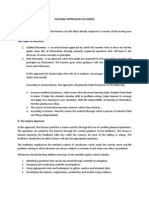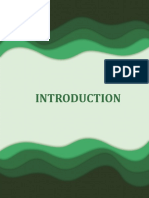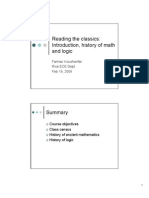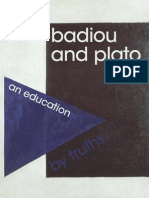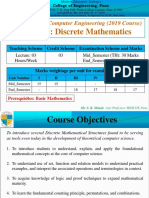Chapter 2 Mathematics in The Modern World
Chapter 2 Mathematics in The Modern World
Uploaded by
new chaisiriwongCopyright:
Available Formats
Chapter 2 Mathematics in The Modern World
Chapter 2 Mathematics in The Modern World
Uploaded by
new chaisiriwongOriginal Title
Copyright
Available Formats
Share this document
Did you find this document useful?
Is this content inappropriate?
Copyright:
Available Formats
Chapter 2 Mathematics in The Modern World
Chapter 2 Mathematics in The Modern World
Uploaded by
new chaisiriwongCopyright:
Available Formats
Chapter 2
MATHEMATICAL LANGUAGE AND
SYMBOLS
Learning Outcomes:
At the end of the chapter, the student should be able to:
1. Discuss the language, symbols and conventions of mathematics.
2. Explain the nature of mathematics as a language.
3. Perform operations on mathematical expressions correctly.
4. Acknowledge that mathematics is a useful language.
Introduction
Mathematics has its own symbols, syntax and rules. It has also its own
language which must be understood and learned. This will help us communicate
ideas effectively and efficiently. One is expected to have a broad understanding of
the language to be able to express correct ideas. The intention of this part of the
course is to expose the students to the world of mathematics as a language in order
that they may be able to read and write mathematics texts and communicate ideas
with precision and conciseness.
Lesson Proper
Lesson 2.1: Characteristics of Mathematical Language
Mathematics, like any other discipline has its own language. It has its own
symbols, syntax and rules. It is a system used by mathematicians to express ideas
and understand the expressed ideas. Mathematics as a language has the following
characteristics:
1. Precise - ability to make precise distinctions
2. Concise - ability to use symbols to be able to express more
MATHEMATICS IN THE MODERN WORLD 15
3. Powerful - ability to express complex thoughts to simpler ideas.
As Peter Hilton said “Mathematics cannot be learned without being
understood - it is not a matter of formulae being committed to memory but of
acquiring a capacity for systematic thought.” Systematic thought does not only mean
reducing everything to symbols and equations it also requires precise verbal
expression. Which means that one should understand first the language of
mathematics before one can use it effectively. Understanding the language requires
us to exert efforts in learning the symbols, syntax, rules and the meaning behind
these mathematical terms.
Lesson 2.2: Expressions versus Sentences
Mathematics as a language has its own vocabulary. Like the English language,
Mathematics has “nouns”, “verbs”, “phrases” and “sentences”.
The following diagrams will help us understand the difference of those terms
when it comes to the context of English and Math.
In the English language, nouns are names of persons, places, things and etc.
Phrases are words or groups of words that do not express a complete though and
sentence is a word or group of words that expresses a complete thought.
MATHEMATICS IN THE MODERN WORLD 16
In the Mathematics language, expressions are nouns. An expression is any
number, variable or a combination of the two separated by an operation. Sentences
in the mathematics language are equations which are either true or false but not
both.
Lesson 2.3: Conventions in the Mathematical Language
There are many symbols used in the Mathematics language but we need to
fully understand the meaning behind those symbols for us to use and communicate
it effectively. A mathematical convention is a fact, name, notation, or usage which is
generally agreed upon by mathematicians. These conventions in the mathematical
language will help us distinguish different types of symbols and operations in a
mathematical expressions.
Lesson 2.4: Four Basic Concepts
Sets (relationships, operations, properties)
A set is a group or collection of objects or numbers. The items in a set are
called members or elements and the symbol “∈” which is read as “is an element of”
is use to denote an element of a set.
We can use the Roster or Set builder notation to denote a specific set.
1. Roster Method – is used to list or enumerate all the members of a set. It is
usually used when there are few elements to of a set to list. When the
MATHEMATICS IN THE MODERN WORLD 17
elements are too many, we can use the triple dots or “ellipsis” to imply
that the set has more elements to list.
Example: The set of even numbers less than 20.
Let A be the set of even numbers less than 20, using the Roster
method:
A = {2, 4, 6, 8, 10, 12, 14, 16, 18}
2. Set Builder notation – is used to denote a set in terms of its common
defining property. This is used when the set has many elements.
Example: The set of even numbers less than 20.
Let A be the set of even numbers less than 20, using the Set-Builder
Notation:
A = { x|x is a n even number less t h an 20 }
Relations
A relation is simply a set or collection of ordered pairs. An ordered pair,
commonly known as a point, has two components which are the x and y coordinates.
The domain is the set of all x or input values. It is the collection of the first values in
the ordered pairs.
The range is the set of all y or output values. The collection of the second
values in the ordered pairs.
Equivalence Relation
o An equivalence relation on a set S, is a relation on S which is reflexive,
symmetric and transitive.
o Reflexive : a∼a
(A set compares to itself)
o Symmetric: If a∼b then b∼a
(If a set has as many elements as another set
then the second set has as many elements as the first)
MATHEMATICS IN THE MODERN WORLD 18
o Transitive: If a∼b and b∼c then a∼c
(If a set has as many elements as another set and
this, in turn, has the same number of elements as a third
set, then the first and the third are also equivalent)
Example 2.4.1: Suppose we have set A and a relation R on A. If A is {0, 1, 2} and R=
{(0, 0),(1, 1),(2, 2),(0, 1),(0, 2),(1, 0),(1, 2),(2, 0),(2, 1)}. Show that R is an
equivalence relation.
Solution:
R is reflexive since it contains (0,0), (1,1) and (2,2). R is also symmetric if for
very (x, y) in R(x, y) must also be in R. Since (0,1) is in R and (1,0) is also in R. R is
also transitive since it contains (0,1), (1,2) and (0,2). Since R is reflexive, symmetric,
and transitive. Thus R is an equivalence relation.
Functions
A function is actually a “special” kind of relation because it follows an extra
rule. Just like a relation, a function is also a set of ordered pairs; however, every x-
value must be associated to only one y-value.
A function consists of three things; (i) A set called the domain; (ii) A set
called the range; and (iii) A rule which associates each element of the domain with a
unique element of the range.
Usually, a function is written as an equation and is expressed in special
notation f : A → B which means that f is a function with domain A and range B. The
functional notation f ( x )where x is an element of the domain.
Example 2.4.2: If f ( x )=x +3 , find f ( 6 ) ∧its inverse .
Solution:
To find f (6), just substitute 6 with x and add 3 in f (x)= x+3. Thus,
f ( x )=6 +3=9 ,which means that is we take 6 as an input, then the output will be 9.
MATHEMATICS IN THE MODERN WORLD 19
The inverse of a function should give us back the original value.
Hence the inverse of f ( x )=x +3 is x−3. If you are going to add or subtract 3,
you wil get the original number.
Injective, Surjective and Bijective Functions
o Injective means we won't have two or more "A"s pointing to the same
"B". In other words, if every element in the range is assigned to exactly
one element in the domain.
Example:
f : A → B where A={a , b , c , d } and B={q , r , s , t ,u }
q
a r
b s
c t
d u
o Surjective means that every "B" has at least one matching "A". If every
element in the codomain is assigned to at least one value in the
domain.
f : A → B where A={a , b , c , d } and B={q , r , s , }
a r
b
c s
d
MATHEMATICS IN THE MODERN WORLD 20
o Bijective means both Injective and Surjective together. A function is
bijective for two sets if every element of one set is paired with only
one element of a second set, and each element in the second set is
paired with only one element of the first set. This means that all
elements are paired and paired once.
f : A → B where A={a , b , c , d } and B={q , r , s , t }
a q
b r
c s
d t
Binary Operations
Binary operation * is an operation which needs two inputs or quantities. A
simple example is the addition operation "+": In 3 + 5 = 8 the operation is "+",
which takes two values (3 and 5) and gives the result 8. Subtraction, multiplication,
division and exponential are also binary operations. The two inputs are called
"operands".
Also, in a binary operation should take and return things of the same type
which means that the inputs and the result must belong to the same set.
Types of Binary Operations
Commutative
A binary operation * on a set A is said to be commutative if a * b = b *
a, for all (a, b) ∈ A (non-empty set).
Example: Both + and ∙ are associative operations on Q. However,
subtraction ¿ is not commutative operation on Q because5−6 ≠6−5.
MATHEMATICS IN THE MODERN WORLD 21
Associative
The associative property of binary operations hold if, for a non-empty
set A, we can write (a * b) *c = a*(b * c).
Example. Both + and ∙ are associative operations on Q. Subtraction (–)
is not associative operation on Z since
( 2−3 )−4 ≠2−(3−4 )
Identity
If A be a non-empty set and * be the binary operation on A. An element
e is the identity element of a ∈ A, if a * e = a = e * a. If the binary operation is
addition (+), e = 0 and for * is multiplication (×), e = 1.
Example. Zero (0) is the identity element for addition on Z, and one
(1) is the identity element for multiplication on Z. There is no identity
element for subtraction on Z, since for all e ∈ Z we have
e is an identity element ⟹ e – 1=1∧1=1 – e
for –
⟹ e=2∧e=0
⟹c
Since 0=2 is false, the first statement is also false; i.e., for all e ∈ Z, e is
not an identity for −¿ .
Inverse
If a binary operation * on a set A which satisfies a * b = b * a = e, for
all a, b ∈ A. a-1 is invertible if for a * b = b * a= e, a-1 = b. 1 is invertible when
* is multiplication.
Example 2.4.3: The set of natural numbers (N) does not have the inverse property
under the operation of addition (+), because while −x would normally be the
inverse for x under addition, there are no negative numbers in the set of natural
numbers. The inverse must be in the set in order for the property to hold.
MATHEMATICS IN THE MODERN WORLD 22
Lesson 2.5: Elementary Logic
Logic is the science of correct reasoning and reasoning is any argument in
which certain assumptions of premises are stated, and then some other conclusion
or fact necessarily follows.
Logic is sometimes called the science of necessary inference.
Proposition is a statement that is either true or false but not both. Variables
such as p, q, r, s and t are used to represent propositions. Propositional Logic is
concerned with propositions and their interrelationships.
Examples of propositions are:
1. Manila is the capital of the Philippines.
2. Mt. Mayon is located in Cagayan.
3. 2 + 3 = 5
4. DMMMSU is a state university.
5. 3 + 6 = 8
If a proposition is true, then its truth value is true and false if not. From the
examples, propositions 1, 3 and 4 are true while 2 and 5 are false.
Simple Statement is a statement that conveys a single piece of information.
We combine simple statements to form a compound statement by joining them with
the different logical connectives. The following table summarizes the different
logical connectives together with its symbols.
Connectives Symbol Name
and ^ Conjunction
or v Disjunction
not ¬/~ Negation
if…then → Implication
iff ↔ Biconditional
Conjunction (and)
Let p and q be propositions. The proposition of “p and q” – denoted by p ∧q,
is TRUE when BOTH p and q are true and otherwise is FALSE.
MATHEMATICS IN THE MODERN WORLD 23
Disjunction (or)
The proposition of “p or q” – denoted p ∨q, is FALSE when BOTH p and q are
FALSE and TRUE otherwise
Negation (not)
Let p be a proposition with a True truth value, then not p is False. The
negation of p is denoted by ¬ p , and read as “not p”
Implication (if … then)
Suppose p and q are propositions, The conditional statement (implication)
p →q is read as “ if p, then q”, where p hypothesis – antecedent – premise and q
conclusion – consequence, which is false only if p is true and q is false.
Biconditional (iff)
Suppose p and q are propositions, the biconditional statement (bi-
implication¿ p ↔q which is read as “ p if and only if q”, is true only when both p and
q have the same truth values.
Example 2.5.1:
Let p and q be propositions “Today is Monday” and “I am a freshman
student” respectively. Find
a. p ∧q : Today is Monday and I am a freshman student.
b. p ∨q : Today is Monday or I am a freshman student.
c. ¬ q : I am not a freshman student.
d. p →q : If today is Monday then I am a freshman student.
e. p ↔q : Today is Monday if and only if I am a freshman student.
MATHEMATICS IN THE MODERN WORLD 24
Truth Table
A truth table displays the truth value that correspond to the values of the
combined/compound propositions. The following table summarizes the truth values
of the above-mentioned logical connectives.
p q p ∧q p ∨q ¬p ¬q p →q p ↔q
T T T T F F T T
T F F T F T F F
F T F T T F T F
F F F F T T T T
Example 2.5.2: Consider the examples in Example 2.5.1, determine the truth value of
the compound proposition if p is true and q is false.
1. p ∧q : T ∧ F=F
2. p ∨q : T ∨ F=T
3. ¬ q : Since, q=F t h en ¬q=T
4. p →q : T → F=F
5. p ↔q : T ↔ F=F
Example 2.5.3: Construct a truth table for the following propositions:
1. ( p ∨q) →( p ∧q)
P q p ∨q p ∧q ( p ∨q) →( p ∧q)
T T T T T
T F T F F
F T T F F
F F F F T
MATHEMATICS IN THE MODERN WORLD 25
2. ( p ↔ q)→( p ∧q)
P q p ↔q p ∧q ( p ↔ q)→( p ∧q)
T T T T T
T F F F T
F T F F T
F F T F F
Lesson 2.6: Formality
Formality is expressed in a form (usually mathematical) such that there is no
ambiguity as to the meaning and implications of its expressions. This implies that
the same statement read by two different mathematicians, at different moments is
supposed to be interpreted in exactly the same way.
The following are excerpts of the study of Francis Heylighen and Jean-Marc
Dewaele “Formality of Language: Definition and Measurement”:
“Linguistic concept of formality, which can be generally characterized as
"attention to the form of expressions", by subdividing it into two parts: surface
formality, characterized by attention to form for the sake of convention, and deep
formality, characterized by attention to form for the sake of clear understanding. We
have argued that the deep part is the most important one, and that the surface
variant will inherit most of its stylistic features from the deep version.”
They have elaborated the definition of deep formality by noting that formal
language is an attempt to avoid ambiguity by minimizing the context-dependence
and fuzziness of expressions. An expression is defined as context-dependent if its
meaning is clear, but only to someone aware of the context in which it is produced.
An expression is defined as fuzzy if its meaning is imprecise even when the context
is known. Since fuzziness basically results from an intrinsic lack of information
about the thing being described, a sender will have much more control over the
contextuality than over the fuzziness of his or her expressions, so that contextuality
may be assumed to be a better indicator of the intended degree of formality.
MATHEMATICS IN THE MODERN WORLD 26
You might also like
- Features of Semantic and Communicative TranslationDocument4 pagesFeatures of Semantic and Communicative TranslationMichaela LugtuNo ratings yet
- Teaching Approaches in ScienceDocument3 pagesTeaching Approaches in ScienceRhodora A. BorjaNo ratings yet
- Mathematical Languange and SymbolsDocument20 pagesMathematical Languange and SymbolsLimzel MañagoNo ratings yet
- 5 The Language of Relations and FunctionsDocument3 pages5 The Language of Relations and FunctionsRafael Jotojot Jr.No ratings yet
- The Language of Relations and FunctionsDocument13 pagesThe Language of Relations and FunctionsAvril Llagas100% (1)
- The Language of Relations FunctionsDocument22 pagesThe Language of Relations Functionsolivia asteriaNo ratings yet
- The Language and Relations and FunctionsDocument22 pagesThe Language and Relations and FunctionsCaladhielNo ratings yet
- Unit 3 - Activity 1 - Activity On The Song Entitled Anak by Freddie AguilarDocument1 pageUnit 3 - Activity 1 - Activity On The Song Entitled Anak by Freddie AguilarKryztell Marie Alar Villaraza100% (1)
- MMW ReviewerDocument6 pagesMMW ReviewerPandora WinterNo ratings yet
- GED Lesson Exercise 2 - GONZALESDocument3 pagesGED Lesson Exercise 2 - GONZALESAdolph Christian GonzalesNo ratings yet
- UTS Student Copy 2021Document105 pagesUTS Student Copy 2021Rachel Anne BodlisNo ratings yet
- Chapter 2Document17 pagesChapter 2Gerckey RasonabeNo ratings yet
- Unary 0 Binary OperationsDocument27 pagesUnary 0 Binary OperationsTin Ateliaga100% (1)
- Math 211 Calculus Ii NotesDocument24 pagesMath 211 Calculus Ii Notesmaikarageorge721No ratings yet
- Chapter 2-MMWDocument10 pagesChapter 2-MMWRr NgayaanNo ratings yet
- Histograms, Frequency Polygons and Ogives: Most Common GraphsDocument3 pagesHistograms, Frequency Polygons and Ogives: Most Common GraphsFajrul Hisyam100% (1)
- Nature of Mathematics: Ge 104 - Mathematics in The Modern WorldDocument10 pagesNature of Mathematics: Ge 104 - Mathematics in The Modern WorldKhem BuenavidesNo ratings yet
- Chapter 3 Problem Solving and ReasoningDocument26 pagesChapter 3 Problem Solving and ReasoningAda Edaleen A. DiansuyNo ratings yet
- Week 10 GEC101 Understanding The Self Obordo CSAB - Copy - Copy - Copy6Document26 pagesWeek 10 GEC101 Understanding The Self Obordo CSAB - Copy - Copy - Copy6Arabela PelotaNo ratings yet
- Section 3.3 The Conditional and The BiconditionalDocument27 pagesSection 3.3 The Conditional and The Biconditionalmister sparklesNo ratings yet
- 4language of LogicDocument6 pages4language of LogicRonie mar Del rosarioNo ratings yet
- Language of SetsDocument17 pagesLanguage of Setsleslie jane archivalNo ratings yet
- Problem Solving and ReasoningDocument52 pagesProblem Solving and ReasoningBretana joanNo ratings yet
- Mathematics in Modern WorldDocument5 pagesMathematics in Modern WorldJhoann Kim TingNo ratings yet
- 2.2 Basic Concepts of Math Language - Sets, Functions, and Binary Operations PDFDocument34 pages2.2 Basic Concepts of Math Language - Sets, Functions, and Binary Operations PDFchris KusanagiNo ratings yet
- Classification and Organization of DataDocument12 pagesClassification and Organization of DataKleinia UysonNo ratings yet
- Final Exam Reasoning Mathematics First 2023Document2 pagesFinal Exam Reasoning Mathematics First 2023Keren Bui ValdezNo ratings yet
- MMW LecturesDocument5 pagesMMW LecturesJohn Rancel MulinyaweNo ratings yet
- MMW Chapter 2Document63 pagesMMW Chapter 2John Marco RomeraNo ratings yet
- Inductive and Deductive ReasoningDocument35 pagesInductive and Deductive Reasoningdreiriego2003No ratings yet
- MMW FinalsDocument18 pagesMMW FinalsErika Joyce AlfaroNo ratings yet
- Chapter 3 Problem Solving and ReasoningDocument83 pagesChapter 3 Problem Solving and ReasoningJOSE BENAVENTENo ratings yet
- Mathematics in The Modern WorldDocument20 pagesMathematics in The Modern WorldPulido Michaela B.No ratings yet
- Module 4Document10 pagesModule 4Christian BesinNo ratings yet
- Brief History of The Order of Augustinian RecollectsDocument7 pagesBrief History of The Order of Augustinian RecollectsBodik TandisNo ratings yet
- Set Operations: Subjects To Be LearnedDocument6 pagesSet Operations: Subjects To Be LearnedTrisha BarriosNo ratings yet
- LESSON 2, Mathematical Language, Symbols & SetsDocument59 pagesLESSON 2, Mathematical Language, Symbols & SetsnhichelcantosNo ratings yet
- HISTORICITY-Albert DondeyneDocument6 pagesHISTORICITY-Albert DondeyneJohn Glenn LambayonNo ratings yet
- Elementary LogicDocument5 pagesElementary LogicJoana Kylie Burce GolingcoNo ratings yet
- GED102 Week 9 WGN - JINGONADocument5 pagesGED102 Week 9 WGN - JINGONAFatimah Rahima JingonaNo ratings yet
- Values Development For Citizenship TrainingDocument7 pagesValues Development For Citizenship Trainingrovic velascoNo ratings yet
- The Meaning of SupplyDocument4 pagesThe Meaning of SupplyJunar Alarcon100% (1)
- Political Science 11 Course Guide and Syllabus (TTH Classes - 1st Sem. 2022-2023)Document29 pagesPolitical Science 11 Course Guide and Syllabus (TTH Classes - 1st Sem. 2022-2023)Ava Laverne ViloriaNo ratings yet
- Human Resource Management Midterm PortionDocument65 pagesHuman Resource Management Midterm PortionProject ManagerNo ratings yet
- Mathematical StatementsDocument19 pagesMathematical StatementsJacquiline Tidoy Bantiles100% (1)
- GRADE 1 - ENGLISH - Q1 Reviewer: Persons Places ThingsDocument2 pagesGRADE 1 - ENGLISH - Q1 Reviewer: Persons Places ThingsmeldeguzmanNo ratings yet
- Module 2.3 Logic and FormalityDocument5 pagesModule 2.3 Logic and Formality22-02923No ratings yet
- Borda Count MethodDocument5 pagesBorda Count Methodmica manjaresNo ratings yet
- Mathematics in The Modern World FINALSmathDocument40 pagesMathematics in The Modern World FINALSmathRadNo ratings yet
- MMW Chap 4 Data Management Part 1Document58 pagesMMW Chap 4 Data Management Part 1Francielo MinaNo ratings yet
- GED0103 Mathematics in The Modern WorldDocument17 pagesGED0103 Mathematics in The Modern WorldGwandaleana VwearsosaNo ratings yet
- MMW Reviewer MidtermsDocument6 pagesMMW Reviewer MidtermsCarreon ChristianNo ratings yet
- The Normal DistributionsDocument9 pagesThe Normal DistributionsJavadd KilamNo ratings yet
- UNIT 2 Mathematical Language and SymbolsDocument85 pagesUNIT 2 Mathematical Language and SymbolsShina Mae Abellera BarramedaNo ratings yet
- College Algebra - Module 1Document18 pagesCollege Algebra - Module 1Mineski Prince Garma100% (1)
- A - Chapter 1 Mathematics in Our WorldDocument49 pagesA - Chapter 1 Mathematics in Our WorldBrian GarciaNo ratings yet
- Chapter 1.3Document25 pagesChapter 1.3SOFIA GABRIELLE IBASCONo ratings yet
- Activity 3Document1 pageActivity 3GCueto Fate AnnNo ratings yet
- Chapter 2.4 Functions As Real World Models PDFDocument29 pagesChapter 2.4 Functions As Real World Models PDFjiiNo ratings yet
- 27 Equivalence RelationsDocument18 pages27 Equivalence Relationsashutosh_impNo ratings yet
- Mathematics-in-the-Modern-World Module 2Document51 pagesMathematics-in-the-Modern-World Module 2Jordan SingaNo ratings yet
- The Language of MathematicsDocument109 pagesThe Language of MathematicsAl-Vi John CorpuzNo ratings yet
- Gecc 102 - Module 1Document13 pagesGecc 102 - Module 1new chaisiriwongNo ratings yet
- 1 Brief History and Nature of DanceDocument16 pages1 Brief History and Nature of Dancenew chaisiriwong100% (1)
- Unit 1 - IwrbsDocument52 pagesUnit 1 - Iwrbsnew chaisiriwongNo ratings yet
- Exercise 1 - Setting Tab Stops: You Have Now Created The Tab Stops Necessary To Insert The Data For The ExerciseDocument2 pagesExercise 1 - Setting Tab Stops: You Have Now Created The Tab Stops Necessary To Insert The Data For The Exercisenew chaisiriwongNo ratings yet
- UNIT 1 - Activity 3 SoftDocument8 pagesUNIT 1 - Activity 3 Softnew chaisiriwongNo ratings yet
- Full Names - HumssDocument3 pagesFull Names - Humssnew chaisiriwongNo ratings yet
- Sample Short StoryDocument5 pagesSample Short Storynew chaisiriwongNo ratings yet
- 2final - Shape - IntroductionDocument38 pages2final - Shape - Introductionnew chaisiriwong100% (1)
- Whether God Exists?Document4 pagesWhether God Exists?Brian Reyes GangcaNo ratings yet
- Can You Help Me? Take This Pencil. X + 2 6: P Q P QDocument29 pagesCan You Help Me? Take This Pencil. X + 2 6: P Q P QTorgynNo ratings yet
- Minimization of Switching CircuitsDocument19 pagesMinimization of Switching Circuitsdiwaker100% (2)
- Stages On The Empirical Program of RelativismDocument9 pagesStages On The Empirical Program of RelativismJorge Castillo-SepúlvedaNo ratings yet
- Microsoft Power Point History of MathematicsDocument10 pagesMicrosoft Power Point History of Mathematicskirankpn22No ratings yet
- Philosophy Lesson Plan - ActivityDocument4 pagesPhilosophy Lesson Plan - ActivitySlaghard AnerajNo ratings yet
- Logic 1 Mcgee SyllabusDocument2 pagesLogic 1 Mcgee SyllabusAmir M.No ratings yet
- David Hume Presentation by Joaquin LatupanDocument14 pagesDavid Hume Presentation by Joaquin LatupanJoaquin LPNo ratings yet
- Badiou and PlatoDocument257 pagesBadiou and Platoakestor100% (2)
- Oxford Scholarship Online: Self and World in Schopenhauer's PhilosophyDocument24 pagesOxford Scholarship Online: Self and World in Schopenhauer's PhilosophyrodrigoaxavierNo ratings yet
- Introductory Lectures On Aesthe - Hegel, GeorgDocument27 pagesIntroductory Lectures On Aesthe - Hegel, GeorgIøn NicølescuNo ratings yet
- Pert 4 Penelitian Ilmiah Dan Jenis PenelitianDocument23 pagesPert 4 Penelitian Ilmiah Dan Jenis PenelitianPengisi DompetNo ratings yet
- A Logical Basis For Measuring Critical Thinking Skills: Robert H. EnnisDocument6 pagesA Logical Basis For Measuring Critical Thinking Skills: Robert H. EnnisImam A. RamadhanNo ratings yet
- Fuzzy Logic PaperDocument8 pagesFuzzy Logic PaperVirat KumarNo ratings yet
- Mathematics and Dialectic in Plato's Republic VI-VII: Kozi AsanoDocument35 pagesMathematics and Dialectic in Plato's Republic VI-VII: Kozi AsanoGiannis DimitriouNo ratings yet
- DM - Unit 1 - PPTDocument92 pagesDM - Unit 1 - PPTUV New MoviesNo ratings yet
- ArgumentsDocument7 pagesArgumentsHussnain KhadimNo ratings yet
- Semantic DocumentDocument4 pagesSemantic Documentfarah zaheerNo ratings yet
- The Project of The Republic I. Republic, Book IDocument4 pagesThe Project of The Republic I. Republic, Book IOLSNo ratings yet
- Persuasive Cornell Notes UpdatedDocument2 pagesPersuasive Cornell Notes Updatedapi-329035384No ratings yet
- Preface, Pages 1-14 Introduction Chapter I Jainism - Its PhilosophyDocument259 pagesPreface, Pages 1-14 Introduction Chapter I Jainism - Its PhilosophyloveofgaiaNo ratings yet
- Concept of Prtyaksha PramanaDocument5 pagesConcept of Prtyaksha PramanaAshwini Parkanthe100% (1)
- Fuzzy Logic Part1Document56 pagesFuzzy Logic Part10129SHIBALIK DHARANo ratings yet
- Review MaterialsDocument75 pagesReview MaterialsGiancarlo BarandinoNo ratings yet
- 03 - Gee2 - WK9 - Analysis, Application and ExplorationDocument2 pages03 - Gee2 - WK9 - Analysis, Application and ExplorationAeri Shim NoonxrNo ratings yet
- Human Flourishing in Science and TechnologyDocument2 pagesHuman Flourishing in Science and TechnologyShay Mitch67% (3)
- Egre, Rossi, Sprenger - Gibbardian Collapse and Trivalent ConditionalsDocument24 pagesEgre, Rossi, Sprenger - Gibbardian Collapse and Trivalent ConditionalsplrvsmuseNo ratings yet
- Feeling and Value, Willing and Action Wehrle M. EdDocument288 pagesFeeling and Value, Willing and Action Wehrle M. EdGabriela De Gante100% (1)

